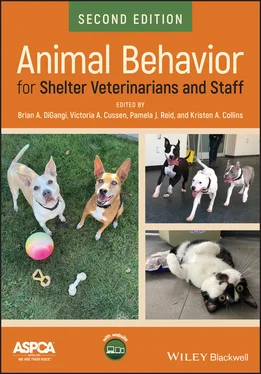46 Wells, D.L. (2019). The state of research on human–animal relations: Implications for human health. Anthrozoös 32 (2): 169–181.
47 White, S.C., Jefferson, E., and Levy, J.K. (2010). Impact of publicly sponsored neutering programs on animal population dynamics at animal shelters: The New Hampshire and Austin experiences. J. Appl. Anim. Welf. Sci. 13 (3): 191–212.
48 White, S.C., Scarlett, J.M., and Levy, J.K. (2018). Characteristics of clients and animals served by high‐volume, stationary, nonprofit spay‐neuter clinics. J. Am. Vet. Med. Assoc. 253 (6): 737–745.
| Category |
Program type |
Benefits/Impact * |
Resources needed |
| To the pet |
To the owner |
To the community |
To the organization |
| Basic needs |
Food banks |
Address basic nutritional needs |
Reduce food insecurity |
Collaborative programs offer a One Health approach to meeting basic needs |
Opportunity for collaboration with key community stakeholders |
Minimal investment in time and resources, particularly if donated food is used |
| Pet‐friendly housing support |
Addresses basic sheltering needs |
Reduces housing insecurity |
Collaborative programs create partnership with attorneys, human social services, and housing organizations |
Opportunity for collaboration with key community stakeholders |
Minimal resources to develop and maintain a database; more resources needed for advocacy |
| Rehoming advice and resources |
Avoid sheltering |
Ideally ease the rehoming process and enhance communication with the new owner |
Facilitate community member connections to address the need for rehoming |
Place the onus for rehoming on the pet owner when feasible |
Minimal |
| Lost‐and‐found programs |
Avoid the negative sequelae of roaming at‐large |
Reduce/prevent the emotional impact of losing a pet |
Reduce the nuisance or dangerous behaviors related to stray pets |
Often required for municipal organizations; touchpoint with the community to provide access to other services |
Moderate to significant use of time but often within normal scope of responsibilities |
| Temporary sheltering |
Prevents permanent rehoming |
Maintains the human‐animal bond at a time of critical need |
Removes a barrier for those in crisis to seek help for themselves |
Opportunity for collaboration through programs that are often very well received by the organization’s supporters |
Moderate investment in time and resources to manage program and provide care |
| Humane education |
Potential for improved welfare |
Increases knowledge regarding pet care and may improve children’s emotional well‐being |
May enhance empathy and correlate with other positive behaviors in children |
Strengthens ties to the community; provides potential for revenue through classes, parties, and camps |
Variable based on the scope of the program |
| Veterinary care |
Spay‐neuter services |
Health benefits of sterilization |
Avoidance of unwanted litters and problematic pet behaviors associated with a sexually intact status |
Reduced pet overpopulation and reduced free‐roaming pets |
Potential for outreach and collaboration with the local veterinary community |
Significant financial and staffing resources typically necessary |
| Access to basic veterinary care |
Health benefits of preventive health care and other primary veterinary care |
Enhances the human‐animal bond by preventing unmanaged medical concerns |
Can be partnered with human health initiatives for a One Health community approach |
Potential for strategic partnerships with human health agencies and/or private practitioners |
Varies based on model but typically requires a moderate to significant resource investment as for spay‐neuter services |
| Return‐to‐field programs |
Health benefits of sterilization and vaccination |
If a caretaker is present, help to reduce colony size and improve colony health |
Reduce the free‐roaming cat population |
Reduce euthanasia of healthy cats and foster collaboration with the community in trapping and caring for these cats |
Require the resources to manage the program and provide sterilization services (but may be outweighed by reduced resources for sheltering and euthanasia) |
| Behavioral care |
Behavior resources |
Improved behavioral health |
Increased knowledge regarding pet care |
May reduce nuisance or dangerous pet behaviors |
Enhance the knowledge base of clientele |
Minimal resources to collate information and review the information with clients |
| Training classes |
Improved behavioral health |
Increased training knowledge, an opportunity for socialization of the pet, and an opportunity for a relationship with a trainer and other pet owners |
May reduce nuisance or dangerous pet behaviors |
Strengthen organizational ties with adopters and potential for collaboration with local training services |
Moderate to significant resource investment, particularly if combined with outreach |
| Behavior hotlines |
Improved behavioral health |
Increased individualized knowledge regarding pet care |
May reduce nuisance or dangerous pet behaviors |
Strengthen organizational ties with adopters and the community |
Minimal to modest resource investment dependent on program structure and expert support |
|
Behavior consultations |
Improved behavioral health |
Increased individualized knowledge and support in addressing pet behavior concerns |
May reduce nuisance or dangerous pet behaviors |
Strengthen organizational ties with adopters and potential for collaboration with local trainers |
Significant resource investment dependent on program structure and scope |
*The desired impact of all safety net programs is to prevent unnecessary companion animal relinquishment. Only benefits more specific to the individual programs are described.
Текст предоставлен ООО «ЛитРес».
Безопасно оплатить книгу можно банковской картой Visa, MasterCard, Maestro, со счета мобильного телефона, с платежного терминала, в салоне МТС или Связной, через PayPal, WebMoney, Яндекс.Деньги, QIWI Кошелек, бонусными картами или другим удобным Вам способом.












